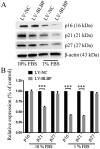Brain lipid-binding protein promotes proliferation and modulates cell cycle in C6 rat glioma cells
- PMID: 29048614
- PMCID: PMC5642387
- DOI: 10.3892/ijo.2017.4132
Brain lipid-binding protein promotes proliferation and modulates cell cycle in C6 rat glioma cells
Abstract
Gliomas are the most common primary brain tumors affecting adults. Four grades of gliomas have been identified, namely, grades I-IV. Brain lipid-binding protein (BLBP), which functions in the intracellular transport of fatty acids, is expressed in all grades of human gliomas. The glioma cells that are cultured in vitro are grouped into the BLBP-positive and BLBP-negative cell lines. In the present study, we found that C6 rat glioma cells was a distinct type of BLBP-negative cell line. Our results confirmed that in the C6 cells, the expression of exogenous BLBP increased the proliferation and percentage of cells in the S phase, in the culture medium containing 10 or 1% FBS. Moreover, exogenous BLBP was found to downregulate the tumor suppressors p21 and p16 in the 1% FBS culture medium, but only p21 in the 10% FBS culture medium. The results of the xenograft model assay showed that exogenous BLBP also stimulated tumor formation and downregulated p21 and p16. In conclusion, our study demonstrated that exogenous BLBP promoted proliferation of the C6 cells in vitro and facilitated tumor formation in vivo. Therefore, BLBP expression in glioma cells may promote cell growth by inhibiting the tumor suppressors.
Figures








References
-
- Balendiran GK, Schnutgen F, Scapin G, Borchers T, Xhong N, Lim K, Godbout R, Spener F, Sacchettini JC. Crystal structure and thermodynamic analysis of human brain fatty acid-binding protein. J Biol Chem. 2000;275:27045–27054. - PubMed
MeSH terms
Substances
LinkOut - more resources
Full Text Sources
Other Literature Sources
Medical
Molecular Biology Databases

